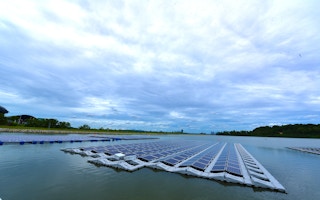Singapore aims to peak its greenhouse gas emissions at 65 million tonnes of carbon-dioxide-equivalent around 2030, and will work towards halving its emissions to 33 million tonnes by 2050.
To continue reading, subscribe to Eco‑Business.
There's something for everyone. We offer a range of subscription plans.
- Access our stories and receive our Insights Weekly newsletter with the free EB Member plan.
- Unlock unlimited access to our content and archive with EB Circle.
- Publish your content with EB Premium.
In the second half of the century, after 2050, the city-state will work towards achieving net zero emissions as soon as is viable, the government announced on Friday.
But in transiting to what it called the low-carbon economy, the government said it intends to continue growing the economy and create more jobs and opportunities.
Singapore’s Coordinating Minister for National Security Teo Chee Hean said in Parliament that the country’s enhanced 2030 nationally determined contribution (NDC)—which refers to nations’ pledges to cut emissions and curb climate change under the global Paris Agreement—is to peak emissions at 65 million tonnes of CO2-equivalent around 2030.
Singapore had earlier pledged, by 2030, to reduce its emissions intensity by 36 per cent from 2005 levels.
Under its latest NDC, Singapore will also expand the scope of its pledge to include a seventh greenhouse gas, nitrogen trifluoride, within this ceiling. The six greenhouse gases included in its pledge so far are carbon-dioxide, methane, nitrous oxide, hydrofluorocarbons, perfluorocarbons and sulphur hexafluoride.
Steps that Singapore will take in the low-carbon transition include increasing adoption of renewable energy and industrial energy efficiency. It will explore tapping regional power grids. It will also study how technologies like carbon capture and storage, as well as hydrogen, can drive decarbonisation. Hydrogen is low-carbon and can be used as feedstock for a range of industrial processes, but requires infrastructure to support its transportation, storage and utilisation.
Whether Singapore’s enhanced NDC goes far enough, however, is debatable. The projected peak emissions of 65 million tonnes CO2-equivalent is a 24 per cent increase over the 52.5 million tonnes emitted in 2017. Scientists have warned that the world has to reach net zero by 2050, if it is to limit warming to 1.5°C above pre-industrial levels by the end of this century.
Dr Matthias Roth, professor of urban climatology at the National University of Singapore, previously told Eco-Business that Singapore should legislate emissions to peak well before 2030.
Organisers of last year’s Singapore Climate Rally want emissions to peak by next year, halve by 2030 and reach net zero by 2050.
The news on Friday comes a week after its Deputy Prime Minister Heng Swee Keat announced in his Budget speech that the country is placing its bets on electric vehicles and plans to phase out fossil fuel vehicles with internal combustion engines by 2040.
He also said a new Coastal and Flood Protection Fund, with an initial top-up of S$5 billion, would be set up. This is to fund the S$100 billion (US$72 billion) or more that the low-lying island will need over the next 50 to 100 years to adapt to climate change and rising sea levels. Last year, its Prime Minister Lee Hsien Loong called climate change defences a matter of “life and death” for the country.










